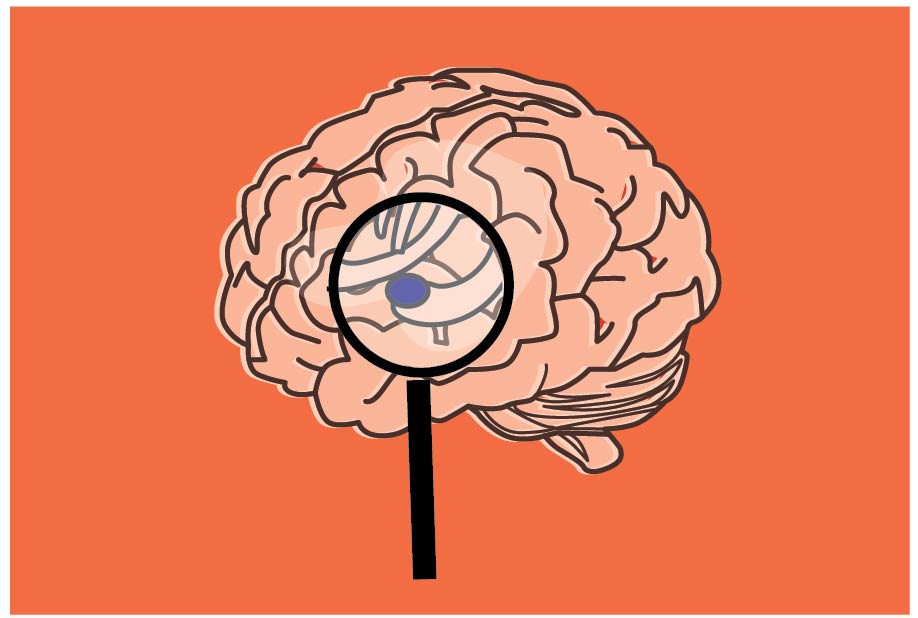
Critical region for emotion and social cues shows decline in cell numbers in autism, increase in cell numbers in neurotypical brains
Researchers at the UC Davis Mind Institute have discovered a key difference in the way the amygdala develops in people diagnosed with autism spectrum disorder. While typical brains steadily gain neurons in the amygdala during childhood, children with ASD begin with a larger number of neurons and experience neuron loss over time.
“We started this current study to try to explain these volumetric changes at the cellular level,” said Cynthia Schumann, an associate professor in the UC Davis Department of Psychiatry and Behavioral Sciences, in an email interview. “The most unexpected finding was that the number of neurons increased [in the amygdala] in typical development; this phenomenon doesn’t happen anywhere else in the brain that we know of.”
The amygdala (Greek for “almond”) is a round structure situated deep in each side of the brain. The small nodules serve important roles in memory formation and emotional responses. Previous studies have shown autism severity correlates with amygdala size.
“The amygdala is associated with regulating anxiety, which is a common feature of ASD,” Schumann said. “However, it is a common feature of many neurodevelopmental and psychiatric disorders. What we do know is that there are substantial changes in the amygdala happening in typical development, especially through adolescence. The amygdala could be altered in many disorders, yet take different developmental time courses and lead to different symptoms.”
52 human brains were collected by Autism BrainNet, a program created to help connect researchers with quality tissue for analysis — 24 brains from neurotypical humans and 28 brains from humans diagnosed with autism were sectioned and examined for size and cell count.
“What we have learned is that the changes in the amygdala are not only happening at a specific age in ASD,” said Thomas Avino, a postdoctoral scholar at the UC Davis MIND Institute, in an email interview. “Instead, it is that the amygdala is taking a different developmental path from childhood to adulthood. The story is complicated by the fact that the amygdala is growing and changing in typical development, and appears to be growing and changing differently in ASD.”
The brains ranged from two to 48 years of age, representing a broad spread of the phases of brain growth.
“In our study, the youngest individuals with autism spectrum disorder (ASD) were 4 years old,” said Nicole Barger, a postdoctoral scholar at the UC Davis MIND Institute, in an email interview. “Thus, we cannot directly address differences prior to this age. It is possible that individuals with ASD have increased neuron numbers earlier in development, but our analysis can only speak to differences occurring from childhood to adulthood.”
Different regions of the amygdala show varying rates of neural cell change. The report indicates that, by adulthood, the number of mature neurons in brains with ASD is 17 percent lower than that of neurotypical brains.
“We have demonstrated that the number of neurons increases in the neurotypical amygdala which is likely due to the persistence (or adult generation) of immature neurons that are present even into adulthood,” Avino said. “Our study is the first to quantitatively examine this developmental trajectory of the amygdala at the cellular level.”
The changes found in this study may be because of cell signals instructing amygdala tissue to develop improperly or a degenerative condition which causes neural cells to die off in childhood and adolescence. The development of the amygdala in neurotypical humans is also not well understood.
“I am currently investigating the positive trend we observed in our non-autistic sample to better understand the broader significance of developmental increases in amygdala neurons and the mechanisms that might contribute to this trend,” Barger said.
The human amygdala will serve as a key target for neuroscientists hoping to better understand how autism develops and what possible treatments can be created to help with symptoms.
“Autism is extremely complex and I think it is very important to consider trajectories and time points when discussing disorders of neurodevelopment,” Avino said. “For example, the tendency for individuals with autism to show more amygdala neurons at childhood ages may be more related to prenatal/early postnatal developmental events such as the production of neurons or the improper culling of excessive neurons. At the other end, I think the idea of a ‘hyperactive’ amygdala in individuals with autism leading to neuron loss is intriguing, is supported by other studies, and may explain the neuron loss we see in adulthood. However, there are many factors at play here and it is likely they interact to produce this complex disorder.”
Written by: George Ugartemendia — science@theaggie.org



